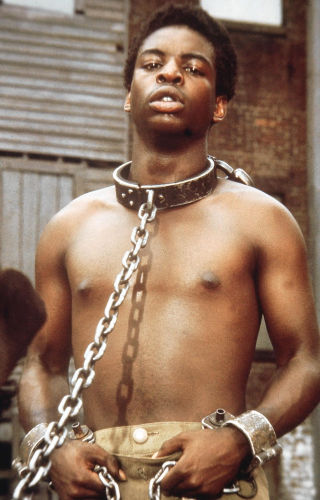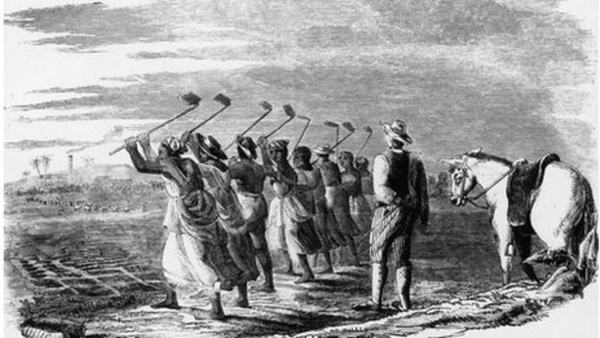Ancient Egyptians believed that a person’s name, the “rn” (ren), was “the foundation of a being as an individual.” A person’s name had a power of its own and lived as long as it was spoken; thus, the proverb, “To speak one’s name is to make him live again.”
This existential quality appears across the African continent, for example, in Akan day names and Yoruba names alluding to circumstances of pregnancy, birth and other phenomena.
Africans converted to Christianity by Europeans have been duped into believing that European names are Christian names and that their adoption is part of one’s Christian identity, with no need to think of their meaning.

One of the very first acts of violence against enslaved Africans in European colonies after the humiliation of the auction block was in forcing them to renounce their African names and adopt names that had no meaning to them and which were often derogatory. This traumatic experience is best demonstrated in the 2013 film, Twelve Years a Slave (adapted from the memoir of Solomon Northup, published in 1853).
Among the strongest reasons that explain why Africans in the Diaspora feel so empowered by the new blockbuster film, Black Panther, are the incarnation of one of Africa’s most spiritual and mystical totemic animals, the use of untainted African personal names and its glorification of melanin complemented by natural African hairstyles. The potential palliative in fictionalising the Kingdom of Wakanda is neutralised by these psychological fortifiers.
Contrary to popular belief, European names historically conveyed meanings—albeit very mundane—reflecting social statuses, occupations, achievements, places of origin or residence as well as qualitative nicknames. Before the use of surnames (in Britain, a long transition period stretching from the 12th to the 19th Century), a person had one name or one name and an occupational label such as Jimmy the carter, which would have transitioned to Jimmy Carter.
Hundreds of these names exist. Some common surnames with obvious occupational identities include Mason, Taylor, Cartwright, Carpenter, Bishop, Earl and Prince. Like the names Ali and Muhammad among Muslims, Europeans have two of their most common names in Smith (metal worker, with variants Smyth and Smythe and its German equivalent, Schmidt) and Jones or Johnson (both meaning John’s son). Other examples of occupational names include Hooper (barrel maker), Lynch (mariner), Hoffman and Spencer (steward). There are also more curious names like Williams (sons of William, which means “desiring a helmet”). Names such as Brown, White, Black often indicated distinctive hair colour or skin complexion.

Because of the cosmopolitan nature of the slavocracy in T&T and the rest of the Caribbean, European names are a linguistic testimony not only to the presence of various European ethnicities but also to their social classes and occupations prior to settling in the Caribbean. The main reason for so many proletarian European names in the Caribbean is the practice of founding colonies with “the scum of scum” of the European working class. It is the consciousness of this absurdity and psychological abuse that led advocates of Black Power to jettison their “slave names” and re-identify with African names.
By a combination of African resistance and the European practice of tagging places of origin to personal names, many African names survived slavery and colonialism. Almost all Akan day names survived mainly as surnames; many places such as Calabar and Mina, and culture names such Lukumi were popular African surnames in nineteenth-century Cuba.
The recording of surnames of enslaved Africans in British colonies began in earnest in the last decade of slavery. Some interesting African place names that appear as surnames in the Trinidad registers are Eloise Congo, Phillip Ogun and Mondesie Macamba. Congo appeared with the greatest frequency.
One of the most common identifiers of African ethnicity, however, was the appellation, “Moor”, and its many variants.
The received knowledge that the African presence in northern Europe is a product of European Atlantic human trafficking is inaccurate. Before Europe was white, it was black. This fact was starkly revealed by British palaeontologists on 10 February, with the discovery of “Cheddar Man,” their earliest known ancestor dating back 10,000 years ago. He was black (BBC online). The melanin acknowledgement, however, came with a focus on his blue eyes. The allusion was not so subtle; it was as if to disclaim Cheddar Man’s Africanity.

Interestingly, just two weeks after the Cheddar Man story broke, other European archaeologists informed the world of their discovery of the oldest abstract paintings in a Neanderthal site in Spain, “long before modern humans are known to have reached Europe on their migration out of Africa.” Indeed, the report emphasizes that these abstract paintings predate the earliest African by at least 25,000 years. Jonathan Jones, writing in The Guardian, even suggests that the Neanderthals might have taught us “everything we know.” Such acclamations tend to challenge the longevity and impact of Africans in Europe.
The ascription “Black” as an ethnic identification of Africans is an English-language transliteration of several related but not exact terms such as Kushite, Ethiop, Negro, “Zanj” and “Habasha” (Arabic) and “Kaffir” (Dutch-Afrikaans). In interrogating the term “Moor” and its several variants, a researcher is more likely to explicate the continuity and statuses of blacks in Europe long after Cheddar Man depleted his melanin to produce a paler hue.
An excellent work on the subject is Ivan van Sertima’s “The Moor in Africa and Europe” in Golden Age of the Moor (edited by Ivan van Sertima).
Moor comes from the Greek word mavro, meaning “black, blackened or charred” (see Ta Neter.com). According to Ta Neter, the Latin-speaking Romans adopted the Greek term as mavrvs, from which it was later transliterated into “maurus” or “mauritius.”
As early as the fourth century AD, evidence from a literary text with the words “a Moor by race” indicates that the term had already transitioned from hue to ethnic identification. By that time the word competed with aethiops as a generic reference to natives of Africa as well as the specific geo-political entity known to Romans as Mauretania, which extended from modern Western Algeria to modern Western Morocco and southward into modern Mauretania.

In his General History published in 1824, Scottish scientist-businessman, Robert Kerr, equated “Moors” with “Kafyrs [Kaffirs] of Ethiopia.” John Etick’s 1783 edition of A New English-Latin Dictionary, confirms that “maurus” was synonymous with “Ethiopic.”
By virtue of pre-historic migrations and historic military incursions and commerce, the Moors were to be found all over Western Europe long before the advent of the European Atlantic slave trade that trafficked thousands of Africans into Europe. Predating the Greek coinage of the term Moor, the Carthaginians of modern-day Tunisia were the undisputed masters of the western Mediterranean.
In the second century BCE, under the leadership of Hannibal, “one of the greatest military strategists in history,” the Carthaginians marched across Iberia (Spain and Portugal), crossed the Pyrenees and the Alps and descended into Rome, defeating several Roman legions. From a viewpoint of race, that was the first Moorish military invasion of Europe. Moorish legions returned as conquerors across Europe under the Roman flag.
The most significant Moorish invasion occurred under newly converted Muslim General Tariq bin Ziyad, beginning 711 AD. Waves of other Moorish invaders followed, the two most noteworthy being the Almoravids of modern-day Mauretania and the Almohads of modern-day Algeria from the 11th to the 13th centuries. Under Moorish rule, Spain and Portugal experienced their first Golden Age of civilization.
Less known to students of history is the Moorish invasion of southern Italy from the 9th to the 12th century. The name Morano Calabro in Italy is derived from Maurus, the Moor. Although sources tell of an eleventh-century BC founding of the village by Romans, a French source on the origin and etymology of the name Morano, states: “Morano est un nom de famille catalan, sobriquet désignant celui qui est brun de peau comme un maure” [Morano is a Catalan family name, used to designate someone whose skin is brown like a Moor’s,” (my translation)].

One of the key genres of evidence of the Moorish demographic in Europe is linguistics. Like many name tags, “Moor” evolved into a variety of personal names. Thus, we have the following: Moore, Morrison, Morris, Morse, Maurice; Maureen/Moreen; and the not so obvious (to many English speakers), Maurits (Dutch), Moro and Moreno (Spanish and Portuguese), Mohr (with variants Morhart, Morhardt, Morehart, Morath, Morese, Morandi).
In some languages, Moore was transliterated as Black, Blackamoor, Negro, Schwarz or Schwarzkopf (German). St Maurice of the 3rd Century and St Victor Maurus of the 4th Century were early Moorish Christian saints.
Beyond Europe and Africa, the Dutch renamed an island, Mauritius, after Prince Maurits of the Netherlands—Prinsz Maurits literally means Prince Moor or Black Prince. Interestingly, Mauritius, lying deep in the Indian Ocean, and with the world’s third largest Hindu population, is one of the African Union’s 55 sovereign states.
Spaniards took the term moreno to the Americas as a generic description of all non-whites, first applying it to native Americans such as Aztecs and Incas as well as Africans and, most recently, African Americans. This deployment of the term was consistent with the Spanish invention of “limpieza de sangre” (purity of blood), the founding principle of modern racism. Likewise, the colonial term morisco was applied to a mixed-race person whose parents were a white Spaniard and a mulatto (an African-Spaniard), the equivalent of ‘quadroon’ in British colonies.
The British retained the term ‘Moor’ and its derivative ‘Blackamoor’ well into the 18th Century. Despite a deportation order issued by Queen Elizabeth l against Moors in 1596, Moorish people continued to fascinate the English and certainly enjoyed positive somatic norm imagery among them.

Shakespeare’s Othello, in the play, The Moor of Venice, for example, was a powerful military general who marries the white, beautiful Venetian socialite, Desdemona. Moors also appear in other Shakespeare plays: Titus Andronicus (written before Elizabeth’s edict of expulsion), Antony and Cleopatra, The Merchant of Venice, and Hamlet (still debatable, but some critics point to certain phrases commonly associated with Moorish identity in the play).
Contrary to popular literature, the defeat of the Moors in Portugal in the 13th century and their expulsion from Spain in 1492 did not relegate their status to that of servants only. In both countries, many Moors became Christians and remained as subjects to their new rulers, which facilitated their continued enjoyment of high status, including membership in the most prestigious military-religious orders, such as the Order of Santiago.
In royal courts of northern Europe, “Moors” were highly prized as specialist entertainers, such as musicians and dancers. One example is Gustav Badin, who was born in Africa c. 1750, was trafficked to Sweden as a youth and became a poet and writer, actor and dancer to the royal court.
The surname Badin can be transliterated as “jesting”, which may indicate his early employment as court jester. Nevertheless, he became extremely wealthy, owning two estates, and was a welcomed member of many Swedish secret societies, including the Freemasons.

Some Moors served as noblemen, as evidenced in several extant paintings. Indeed, some of the oldest royal crests and coats of arms in central Europe display the full bodies or heads only of “Moors.” Here again there is some debate over the status of these figures; some sources claim that they represent a celebration of victory over the Moors.
But, even so, many of these crests show Moors with royal crowns, in which case it may also be argued that they are equally a celebration of Moorish royalty.
Editor’s Note: Click HERE for Part One of Dr Claudius Fergus’ four-part series on Black Identity when he considers the symbolism of the Black Panther film and negative Afro-centric stereotypes.
Claudius Fergus is a retired Senior Lecturer in the Department of History at UWI’s St Augustine Campus who specialises in the abolition of British colonial slavery and its transatlantic slave trade.
His major work on the subject is Revolutionary Emancipation: Slavery and Abolitionism in the British West Indies (2013). He has other extensive publications in peer-reviewed journals and edited books.
 Wired868 Wired868 for smart sport news and opinion
Wired868 Wired868 for smart sport news and opinion







Europeans were very destructive back in the day. Destroyers of civilizations they were. Which is why it is all the more significant that white Americans created the Black Panther movie which has become a source of pride and empowerment for black people. A lot of appreciation to Marvel and Disney for making this possible.
Interesting….
But what I do this man? He have to tell everybody how I get my name?
And not a word about Lie-bird and Wall-cut!
A very informed commentary
Many of us who were born in the 70s have African names because of what the article speaks to. Babatunde Olatunji came to Trinidad in 1976. I am named after him. I went through primary school with lots of children (not all) making fun of my name. I lived to stand in a stadium where Olatunji Yearwood had 10s of thousands singing it loudly. Having to defend my name played a large role in my development. It really is not something we should take lightly.
I hear that. Lol.
I am sure you do Lasana lol